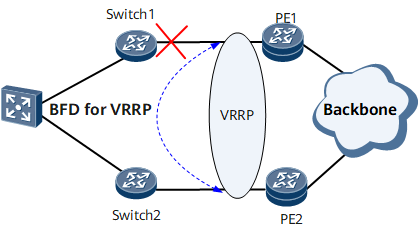Fault on the Link Between PEs
BFD can be used to monitor the link between PEs.
VRRP and BFD
BFD and OAM are similar in terms of defining a set of mechanisms, including detection, fault notification, and switchover. For BFD and OAM, detection is carried out by sending fast detection packets along a preset path to detect the link status. If the detection packets cannot pass through the link, the packets are dropped. To prevent jitter, the maximum number of detection packets sent within a period can be specified. When the number of the lost detection packets reaches the set value, the link is considered as interrupted.
BFD is a bidirectional detection mechanism, and its detection packets are sent bidirectionally. If one end does not receive the detection packets within a specified period, the end assumes that the link is interrupted and reports to related modules to perform switchover.
As shown in Figure 1, PE1 and PE2 form a VRRP group, functioning as a backup for each other. VRRP monitors the BFD session. For example, PE1 serves as the primary PE. When the link between Switch1 and PE1 fails, the failure is fast detected with BFD and reported to VRRP. The VRRP group fast switches traffic, and then PE2 becomes the primary PE.
